
by DharamCW | Nov 30, 2024 | Project Management
Introduction: Navigating the VUCA Landscape
As the world is moving towards hyper-active technological disruption, its high time for Project Managers to learn effective ways to deliver value in a VUCA environment. There are plethora of examples demystifying the concept of VUCA. But very few revitalizing its impact on project management and value delivery. This article is framed to have a clear picture on how it works, the balancing act, mindset and delivering value from a Project, Program, Portfolio Manager Perceptive.
Understanding VUCA

Understanding VUCA
Let’s get started with what VUCA stand for – Volatility, Uncertainty, Complexity, Ambiguity. It was formally developed by US Army War College in 1987 after the Cold War, to reflect how to oversee complex multilateral world situations. The acronym VUCA is derived from the leadership theories of Warren Bennis and Burt Nanus. Delivering value have direct correlation with the economic equation of the countries in which projects involved. The dynamics of environment changes impact the project success direction. Those adversaries needed to handle with focus mind, determination, perseverance by the Project Leaders. The following questions put forth in front of the emerging Project Leaders whether they really understand the condition and situation of VUCA:
- Do I understand the visibility of the project during volatile conditions?
- Do I have a better understanding of unpredictability of the problems that the project undergoes during uncertainty?
- Do I have clarity of mindset when interrelated forces influence the project decision making process in complex environments?
- Do I realise the root-cause circumstances that lead to project ambiguity?

What is VUCA?
All these four questions streamline Project Manager to understand his unknowns – unknowns and better deal with this environment. Let us have a briefing on VUCA,
- Volatility: The rate of change or churn in business environment which directly affects the daily operations of the project. The Project Managers will always be in bed of thorns to mitigate the volatile situation and try to settle into normal rhythm.
- Uncertainty: The world is full of surprises when delivering value, that too for project managers it will be high potential for surprise due to lack of predictability in an uncertain environment. They need to have good assumptions capabilities to plan for future uncertainties.
- Complexity: Diverse global supply chain gets impacted directly with geopolitical, economical, dynamics of industries add complexities to the project success. Better observing of interrelated forces is need of the hour for the Project Managers.
- Ambiguity: The common misunderstandings and unclear realities cause project delays affecting the value delivery process. It naturally makes it difficult to construct risk mitigation plans.
The Impact on Project Management in VUCA World
VUCA influences project, program, and portfolio management, particularly in high-stakes environments. Whether it is a good sign or bad sign depends on the mindset of the Project Manager. Can we eliminate VUCA is a big question mark among the Project Leaders. We need collective responsibility when handling VUCA and one step at a time approach. Agile approach is good to proceed with but not the absolute one to stick on. As a project manager we need to dynamic and adapt to the changing environment and be hybrid to mitigate the risks and challenges VUCA environment brings into the project.
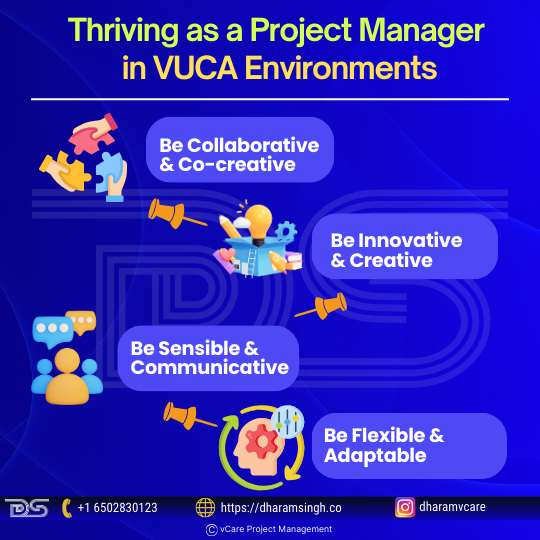
Thriving as a Project Manager in VUCA environment
Some tips for Project Manager to thrive in such environments:
Be Collaborative & Co-creative: Project Managers need to have meaningful collaborations with their team members. Their options, problem solving instance should be appreciated and involved in the decision-making process. Positive collaboration leads to positive co-creation combining for best value-based project delivery.
Be Innovative & Creative: Developing child-like mentality with outlook of creativity Project Managers can do wonders with innovations in their projects. Both have close twin knots, losing one will automatically supress the other.
Be sensible & communicative: Here we trigger the sensibility in voicing with clarity to your entire stakeholders – sponsors, team members, top management, external and internal state actors. Project Manager’s voice should be uniform throughout the top and bottom of the pyramid. This helps to face disruption with united response.
Be flexible & adaptable: Project Managers need to be flexible as grass, dancing to changes in project environment in the VUCA world. Adaption is a must from all levels which need patience and fair amount of training from the organization.
VUCA environment should be seen an opportunity rather than a challenge for organizations to thrive. These tips will be helpful for Project Managers to position themselves with resilience in such environments.
Strategic Leadership in a VUCA World
According to Wikipedia, Andrew Porteous quotes “Failure in itself may not be a catastrophe. Still, failure to learn from failure is.” Project leaders must understand there is no fool proof techniques to address VUCA environments. The only solution is fail fast, fail safe and learn from failures. While this mindset is difficult to grasp but have a sense of community to better positive predictions. Both introspections and evaluations needed to navigate and thrive in such environments. Connecting the dots between strategy and delivery results in better project outcomes. The Project Leaders performs the balancing act between the two. How well they balance need greater amount of critical analysis.
Cultivating Versatility
Developing adaptable leadership styles to manage unpredictable challenges aids the Project Leaders to manoeuvre better reliable strategies for projects. A pragmatic approach of leadership will enhance the decision-making process. The project duress created from the realms of political, economic, technical, social, market, nature calamities like Covid-pandemic gives a moral responsibility for leaders to rethink their leadership style. The harder problems of technological imbalances due to Artificial Intelligence (AI) making it difficult to craft strategies.
According to MIT Sloan Management Review, change management and emotional intelligence top the list of skills leaders to focus to steer the teams for project success. There is a serious limitation and notion of inadequate performance of leadership in these skills. So, organizations can address such extreme mishaps in their leaders by developing versatile leadership. Versatile leadership is forgoing continuous adjustments to their behaviour, meticulously applying right approach, to the right degree, for the circumstances at hand.
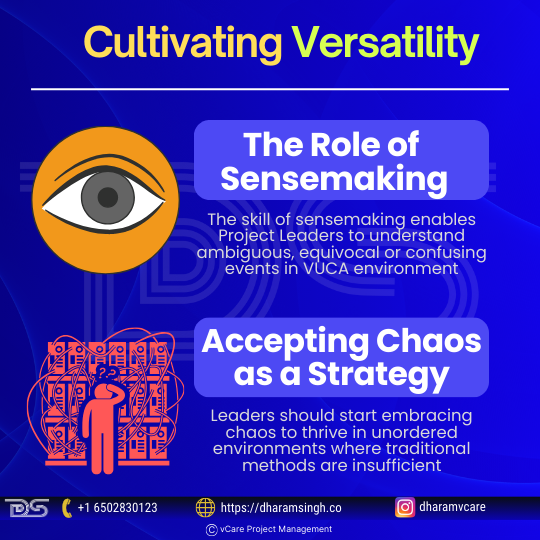
Cultivating Versatility
The Versatile Leader mind works in the absence of imbalance, fostering clear vision to handle tough environments. F. Scott Fitzgerld, in his 1936 essay “The Crack-Up,” quotes “the test of a first-rate intelligence is the ability to hold two opposed ideas in the mind at the same time, and still retain the ability to function.” This is the major challenge a Versatile Leader should pass by adoring wide and flexible range of behaviours
- The Role of Sensemaking: The root causes of imbalance is due to strategic-operational dualities faced by the leaders. The skill of sensemaking enables Project Leaders to understand ambiguous, equivocal or confusing events in VUCA environment. Sensemaking techniques aids for interpreting complex situations and making informed decisions in shifting markets. These capabilities help leaders to drive organizations forward, by having a clear 360-degree vision on environment they work upon.
- Accepting Chaos as a Strategy: Leaders should start embracing chaos to thrive in unordered environments where traditional methods are insufficient. From exponentially increasing technological advancements, economic and political aftershocks, disruptions like these have significant impact on the global supply chain. A well-engineered leadership mind will craft chaos as a strategy framework to streamline business operations for smooth project handling.
Balancing Speed with Thoughtfulness
In the fast-paced rapidly changing environment balancing speed with thoughtfulness is a daunting task for Project Managers. Ambitious targets in short durations leads to disrupt project progress leading to project delays and later project failures. Setting vibrant goals dominate the modern workplace. The thoughtfulness of leaders to change their conventional wisdom towards goal setting is key.
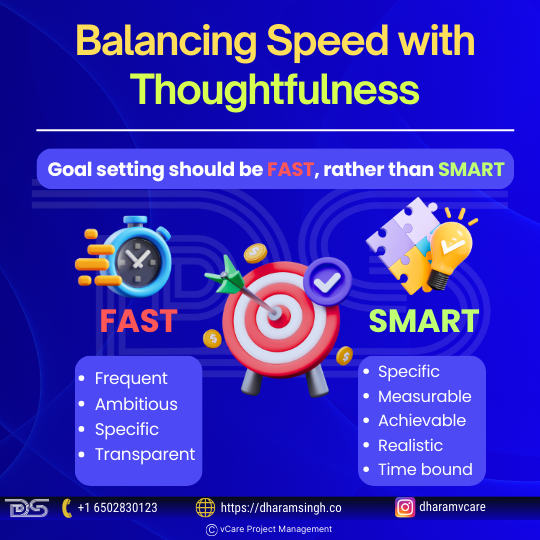
Balancing Speed with Thoughtfulness
As goals drives strategic execution of value delivery, interdependencies of silos plays a vital role for balancing the delivery value chain. A word of caution should always be there in mind of Project Managers when balancing speed with thoughtfulness. Goal setting should be FAST (frequent, ambitious, specific, and transparent) rather than SMART (specific, measurable, achievable, realistic, and time-bound) in VUCA environment.
The Danger of Speed-Centric Goals
Creating value quickly is the new paradigm shift, organizations seek to transform all or part of their businesses. Speed-centric goals lead to high performance of trajectory for the organization but do have the adversity of total failure push back. Proper prioritization of risks is needed to achieve rapid time-bound outcomes. The Project Leader should construct a rigorous cluster of plans in short-duration sprints to overcome potential long-term consequences with thoughtful value delivery.
Prudent Risk Management vs. Aggressive Growth
Too match the pace of market demands in the digital age, the pivot of risk-taking is quintessential for Project Leaders safeguard the organizational immune system. In today’s scenario avoiding risks is not a priority, leaders need to be proactively involved in identifying, evaluating, and strategizing risk mitigation plans. Risk-taking foster growth and innovation in VUCA world. Leaders should sharpen their risk management capabilities and be prudent. A prudent risk taker maintains calmness during uncertain times and able to show resilience with sound and rational decision-making. Rather than focusing on aggressive growth, Project Leaders need to navigate a path to smart growth. Organization’s reap multiple benefits by having “The Growth Corridor” balancing between minimum growth and maximum growth to drive innovation and survival at the marketplace.
Enhancing Communication and Team Adaptability
Organization’s stability dismantled when fear of disorders overlooks in the mind of employees from the top to bottom management. To overcome stagnation and steer through treacherous waters of VUCA, the Leader should communicate effectively. VUCA communication leans towards sleek perfection, setting clear direction and rallying behind employees’ voice. Leaders unify team adaptability call to action of cohesive strength to face the battle fluctuations and achieve value delivery.
Clear Communication in a VUCA Environment
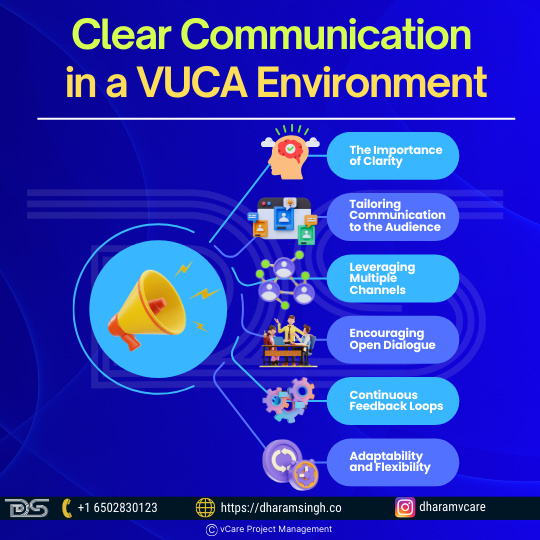
Clear Communication in a VUCA Environment
Effective communication is crucial yet challenging in VUCA world. Shifting dynamics of the workplace needs strategies not only communicate information clearly but make sure to reduce friction across the realms of the various verticals and horizontal in the organization. Let us walkthrough some of the effective VUCA Communication tips:
- The Importance of Clarity: Clarity in communication helps reduces misunderstandings, align team efforts, and reduce the friction that often arises in high-stakes, rapidly changing environments.
- Tailoring Communication to the Audience: Understanding the audience’s pulses to streamline communication.
- Leveraging Multiple Channels: Avoid bottlenecks and constraints by leveraging multiple channel communication.
- Encouraging Open Dialogue: Open dialogue fosters a culture of sensibility leading to more transparency, trust, and accountability, which are vital in uncertain environments.
- Continuous Feedback Loops: Creating continuous feedback loops allows teams to quickly adjust their communication practices as the environment changes.
- Adaptability and Flexibility: Both adaptability and flexibility not only improve clarity but also helps to maintain morale and cohesion among teams facing uncertainty.
Continuous Improvement of Skills
Keep pace with the evolving demands of a VUCA world, creating a learning organization is needed. It should need to be embedded into organizational culture fostering continuous improvement. According to Klaus Schwab in The Fourth Industrial Revolution, the integration of advanced technologies like Artificial Intelligence (AI) and Internet of Things (IoT) into everyday business processes means that the skills required today may be obsolete tomorrow. Continuous learning ensures that Project Managers can adapt to these rapid changing shifts, maintaining their relevance and effectiveness in VUCA world.
Conclusion: Thriving Beyond Boundaries
Embedding resilience into the Project Manager to thrive in VUCA world is a never-ending experience and experiment that organization keeps on retrospect for betterment. Delivering value in an increasingly boundaryless world, creating positive hopes of survival lies in the hand of versatile leaders. Such architecting leaders able to cultivate better systems, structures, culture, possibilities, and autonomous decision making to teams, in chaos.
The Project Leaders should develop: sensemaking with life-long learning, balance speed with thoughtfulness, managing risk with growth mindset, prioritize communication, skill development, foster a culture of continuous improvement, and embrace versatility, to deliver value in VUCA world.

by DharamCW | Oct 28, 2024 | General
Program/portfolio managers must make significant and minor decisions in the ever-changing project management environment. In many instances, their judgments and actions due to their more critical decisions may significantly influence their well-being and the prospects of clients and team members. Moreover, such decisions can impact the very nature of our jobs and even the lives of others who rely on them.
As equal to decision-making, problem-solving skills are essential in project management. Problem-solving is a project management skill that combines creative thinking and strong analytical abilities to assist effective problem solutions. This skill allows the project leader to look at challenges from a different angle and assist in designing and implementing successful solutions for making great decisions.
It’s easy to understand how, in problem-solving, recognizing simple solutions to complicated challenges might benefit the project and the company. Still, not all competent Project Leaders are capable of doing so. To be an effective problem solver and decision maker, the program/portfolio manager must possess specific skills and techniques to manage the project successfully.
Understanding the Decision Making Process in Project Management
All managers and other interested stakeholders must have a thorough grasp of decision-making in project management. The project will only then be able to progress toward the final delivery phase while maintaining the established timelines. The project runs a significant risk of stagnating or moving extremely slowly in this absence.
However, many businesses need help on several fronts because they need to recognize the value of decision-making in their management teams.
A McKinsey survey found that roughly 80% of professionals thought their firms’ decision-making processes could have been more efficient. Furthermore, the firms that demonstrated superior decision-making skills and topped the survey had better financial and performance outcomes.
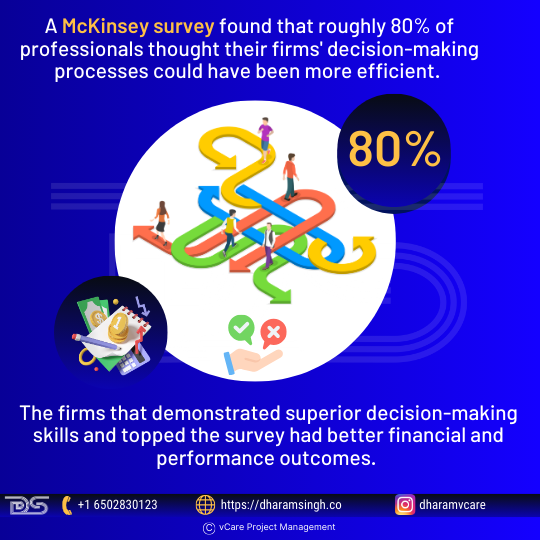
Why Efficient Decision-Making Matters for Firms
Decision-Making Types in Program/Portfolio Management
Decisions need to be made regularly in project management. Most are minor, but others are significant and will determine whether the project succeeds or fails. The same applies to program/portfolio management. Final choices can be reached using either an intuitive or logical method or a combination of the two. More intricate conclusions typically need a more formal, systematic approach incorporating intuition and reasoning. Not all decisions are the same. Management must make many decisions during a project, and each decision-maker is unique. The most common ones are listed below:
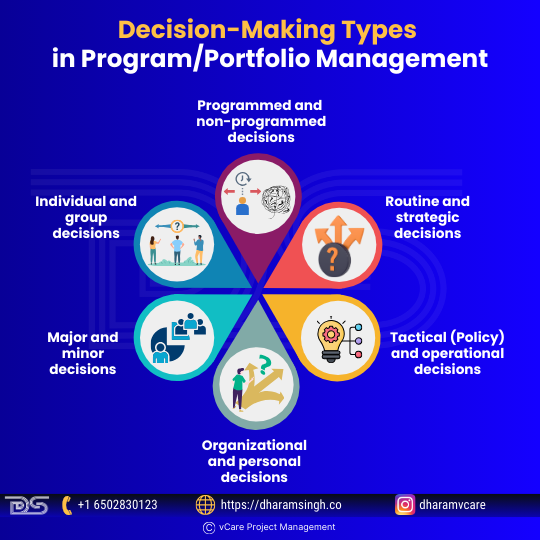
Decision-Making Types in Program/Portfolio Management
- Programmed and non-programmed decisions
Programmed decisions are concerned with problems of a repetitive nature or routine type matters. For example, decisions of this type may pertain to purchasing raw materials, granting leave, and supplying goods to the employee. Non-programmed decisions are made in challenging situations with no clear solution. These decisions need more attention, resources, and time and are usually made at a higher level.
- Routine and strategic decisions
Routine decisions affect the overall operation of a project and can be made rapidly. Within the broad policy framework of the project manager or the organization, ample powers are granted to lower ranks to make these decisions. However, strategic decisions are essential and affect objectives, organizational goals, and other important policy matters. These decisions usually involve a program’s orientation or huge investments in portfolios, are non-repetitive, and are taken after careful analysis and evaluation of alternatives.
- Tactical (Policy) and operational decisions
Portfolio managers make policy decisions that have a long-term impact on the functioning of the concern. For example, decisions regarding how many projects can be run each time according to the budget are policy decisions. On the other hand, operational decisions relate to the day-to-day functioning or operations of the business. Middle—and lower-level managers make these decisions. For example, decisions concerning the payment of bonuses to employees are operational rather than policy decisions.
- Organizational and personal decisions
When an individual decides their responsibilities and tasks within the project, it is an organizational decision. But, if the individual decides on personal matters, it’s a personal decision. The authority to make organizational decisions may be delegated, whereas personal decisions cannot.
- Major and minor decisions
A decision related to increasing the number of resources by 50% is a major decision. A minor decision, for example, is that the superintendent can purchase office stationery.
- Individual and group decisions
When an individual decides within an organization, it is known as an individual decision. However, when it comes to more crucial decisions, more stakeholders need to engage and assist in making a decision. Therefore, it is interesting to investigate in which cases a project manager should involve other project members.
Decision-making Tools and Techniques
Project managers frequently employ additional measures to support the validity of their decisions. While the fundamental concepts remain the same, hundreds of distinct ways and tools are available. A mixture of these strategies can also be employed to make better decisions. Project managers would benefit from knowing which are appropriate and applicable in any given situation.
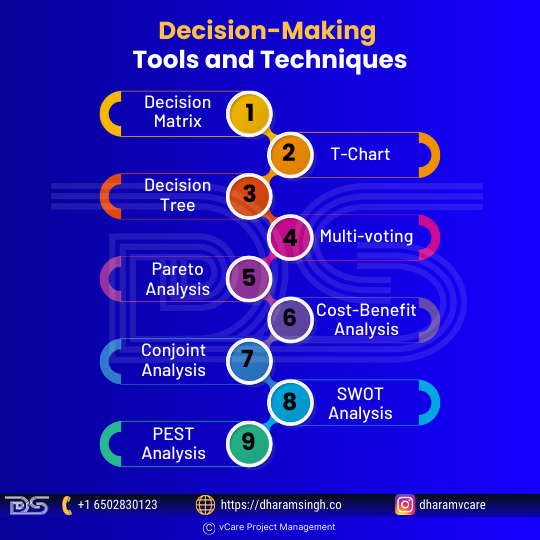
Decision-making Tools and Techniques
- Decision Matrix: A decision matrix examines all of a choice’s possibilities. When utilizing the matrix, create a table with all the alternatives in the first column and the criteria influencing the decision in the first row. Users then rate each choice and choose which criteria are most important. After that, a final score is calculated to determine the best option.
- T-Chart: This chart analyzes the benefits and drawbacks of the alternatives. It guarantees that all of the advantages and downsides are considered when deciding.
- Decision Tree: This is a graph or model for assessing each option and its outcomes. This approach is also used for statistical analysis.
- Multi-Voting: This is utilized when multiple people decide. It helps narrow down many possibilities to a smaller one that leads to the final decision.
- Pareto Analysis: This technique is used when making many decisions. This analysis aids in selecting which decisions should be made first by calculating which ones will have the largest overall impact.
- Cost-Benefit Analysis: This strategy assesses the financial implications of each feasible alternative to arrive at the most economical conclusion.
- Conjoint Analysis: Business leaders use this strategy to assess consumer preferences when making decisions.
- SWOT Analysis: This planning tool examines SWOT (strengths, weaknesses, opportunities, and threats).
- PEST Analysis: PEST, which stands for political, economic, social, and technical aspects, can help decision-making and timing by analyzing external factors. This method takes current trends into account to forecast future ones.
Importance of Decision-Making
Decision-making is an acquired skill rather than an inherent one that is in high demand in the workplace. However, employers consider it an appealing trait as it signifies a good leader. Therefore, demonstrating your decision-making abilities can help you advance your career and accomplish company objectives and goals.
Here are some of the benefits of making correct decisions:
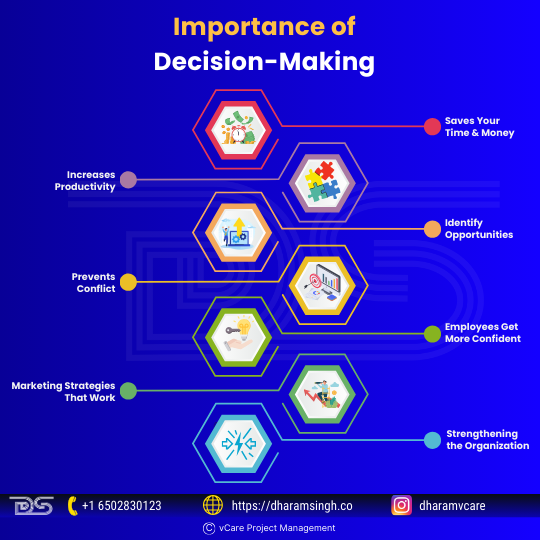
Importance of Decision-Making
- Saves Your Time & Money
Ineffective decision-making requires some time and depletes the motivation of those engaged. The less time you waste making rapid decisions, the better. When it comes to running a business, time is money. Wasting time is the same as wasting money.
- Increases Productivity
When management excels at making decisions and developing good ones, it will boost the workforce’s productivity. Employees will be motivated, for one thing, since they know where the organization is heading. They will strive with the conviction that their efforts will succeed. All time is preserved because the management team is convinced that their activities will correctly guide their organization.
- Identify Opportunities
The key is to recognize the opportunities in front of you and be able to act on them. If there is a great demand for a product in the market and your firm can offer it, wrong or delayed decision-making may prevent you from focusing on it. On the other hand, poor decision-making can make opportunities appear non-existent.
- Prevents Conflict
A manager’s failure to make strong, fair decisions can lead to workplace conflict. Conflicts in the lower tiers also occur when management needs to be more assertive and leave more decisions to their employees. Good decision-making skills can prevent employee conflicts regarding which idea is better for their team or how to maintain a project.
- Employees Get More Confident
Project leaders can become role models and show their employees they are good decision-makers. As a result, employees will trust and follow them confidently, even in the darkest times. When their staff feels that they trust their decisions at every moment, they are more likely to develop new innovative ideas that could benefit the overall business.
- Marketing Strategies That Work
Several critical considerations must be made when implementing successful marketing campaigns. Decision-making is the most important factor in developing strategies and making them stand out. No matter how good the products or services are, the firm will only reach its full potential if it can effectively advertise its brand.
- Strengthening the Organization
Everyone has an equal right to participate in the management of the organization. This aspect fosters a spirit of teamwork and solidarity among those who work there, improving the organization’s overall productivity and strengthening its general structure. Decision-making allows individuals working in an organization to convey their ideas equally.
Decision-making and its impact on problem-solving
The importance of decision-making in problem-solving is apparent and an essential component of efficient project management. A project manager’s capacity to make sound decisions and solve problems correctly is critical since it influences organizational functioning. Problem-solving and decision-making are sometimes inextricably linked; one must better decide to solve a problem.
Problem-solving is a key skill that makes one an excellent project leader. Problems are unavoidable when it comes to project management. Because we all encounter similar scenarios in our everyday lives, what makes a difference is knowledge and how well we use it to tackle a present or looming problem. In project management, problem-solving and resolution are strategic processes. As a result, one won’t be able to master that talent overnight. Instead, it requires incremental learning, using a framework, and preserving some critical factors.
Why are problem-solving skills necessary?
When potential employers discuss problem-solving, they aim to assess how team members use this talent to assist decision-making in the company’s day-to-day operations. Here are four reasons why problem-solving skills are vital in the workplace:
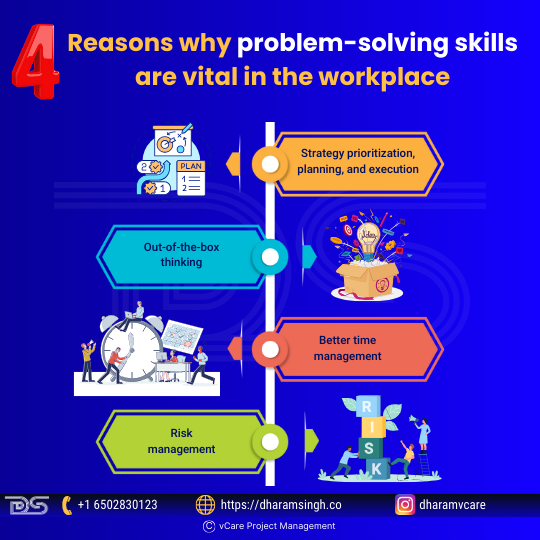
Why are problem-solving skills necessary?
- Strategy prioritization, planning, and execution
Efficient problem solvers may thoroughly examine consumer requirements and devise a strategy that allows them to give outstanding service to their intended audience. Their expertise is in simplifying procedures by eliminating bottlenecks.
- Out-of-the-box thinking
Problem-solving and creative thinking are inextricably linked. Finding a dynamic and innovative solution to a problem is not a matter of finding an instant solution but a dynamic and innovative solution. This mindset assists the company in staying ahead of the curve and gradually improving the workforce’s competence.
- Better time management
When an issue emerges, it must be resolved as soon as possible. Employees with strong problem-solving abilities are laser-focused on what is critical to the organization, can roll with the punches, and can meet tight deadlines.
- Risk management
Effective planning is a necessary problem-solving ability. Problem solvers may respond rapidly to short-term circumstances while keeping an eye on the future. Their positive approach toward learning agility enables them to foresee future challenges based on prior experiences, industry trends and patterns, and current events.
Problem-solving Techniques
Complex problems might be challenging to solve, yet difficulties can be addressed when the correct tools are used. Aside from sophisticated management tools, here are some tools and technologies that can help with problem-solving approaches in your everyday work.

Problem-solving Techniques
- 5 Whys – Understanding the problem better is a wonderful strategy to find the core cause.
- Fishbone analysis – used to visualize the fundamental causes of an issue. Simple to use in conjunction with ‘5 Whys’ or ‘Mind mapping’ to brainstorm and discover the source and impact of any problem.
- Silent brainstorming – allows everyone to engage in idea generation since the loudest and quietest persons will contribute equally. This technique is useful because everyone’s point of view is equally valid.
- Mind maps – are organized visual representations that allow one to exchange ideas, thoughts, and solutions like your brain does. You immediately describe the issues, discuss new ideas, and eventually reach a team agreement that can lead to a successful solution.
- Six thinking hats – This technique allows your team to approach challenges from several perspectives, concentrating on facts, creative ideas, or why some solutions may not work.
- Agreement certainty matrix—another fantastic visual tool for brainstorming issues and challenges. It categorizes them as simple, complicated, complex, or chaotic domains to help teams agree on what technique should be utilized to handle the real problems impacting them.
- Conversation café: This allows the team to have constructive conversations with less argument and more active listening. The problem is addressed in rounds of dialogues until a consensus is reached on the best problem-solving technique.
- Design thinking: When you’re stuck for new ideas, the 5-step approach will help you empathize with the problem, then define and create new concepts before prototyping and testing them.
What are the critical problem-solving skills?
Problem-solving skills enable firms to seek and recruit intellectually equipped personnel who can handle anything their professions throw at them. Problem solvers can watch, assess, and act quickly when the situation demands it- without negatively impacting the business. The following are the top problem-solving skills in the workplace:
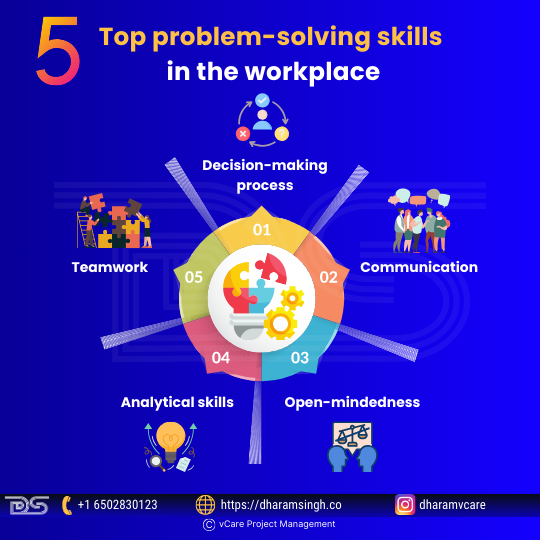
Top problem-solving skills in the workplace
- Decision-making process
Problem-solving requires the ability to make decisions. One can only solve it if one fully comprehends the issue and decides to take action. Decision-making abilities enable experts to rapidly choose between two or more solutions after weighing the benefits and drawbacks of each.
- Communication
Communicating the problem and offering remedies vocally and in writing is an art in and of itself. However, proper communication ensures that solutions are implemented successfully and that all parties engaged in the disagreement agree.
- Open-mindedness
Open-mindedness is the readiness to explore new ideas and look at things from a new viewpoint. When faced with an issue, consider all of its viable solutions. Being curious and observant allows one to be a better problem solver.
- Analytical skills
Almost all problem-solving scenarios need analysis, such as predicting, critical thinking, or troubleshooting. Analytical skills allow one to comprehend the situation better and generate effective answers based on facts and data.
- Teamwork
Collaboration is essential for keeping communication lines open, problems cooperatively addressed, and the team aims before personal ambitions.
Team dynamics are important in problem-solving because they allow one to work together with others toward a common objective.
Final Thoughts
The majority of problems start modestly. Creative program/portfolio managers are responsible for finding solutions as quickly as feasible. The longer they wait, the worse the situation will get.
They may break out of that cycle with a strategic problem-solving framework and quickly find solutions to difficulties using ideal project management automation technology. However, making decisions is crucial to solving problems. Making decisions may be a painstaking process in project management. However, the decisions made inside the team significantly impact a project’s success.
In the future of employment, net new jobs will be created at the same pace as dying jobs. Human talents such as creativity, decision-making, problem-solving, invention, and critical thinking will become more in demand as technology replaces employment requiring repetitive and boring operations. Organizations that get a head start on measuring these human talents in their workforce now and provide strategic learning and development opportunities to upskill them will gain a competitive edge as we enter the Fourth Industrial Revolution.
Jobs we will never see coming will rise rapidly in the future of work (or what many call “The Fourth Industrial Revolution”). The “proper” professional path or education of an ideal individual for these professions will not be clear. We will need to quantify people’s human talents to position them in positions; not only are these skills transferable across unconventional career choices, but these distinctive human skills will also be protected against automation.
Thus, advanced certifications like PMP®, Agile, PgMP®, and PfMP® certifications can help one develop project management skills, be a good problem solver, be a more competitive candidate for positions, and be a successful project leader. In today’s competitive business world, one must be skilled and experienced to succeed and grow one’s career.








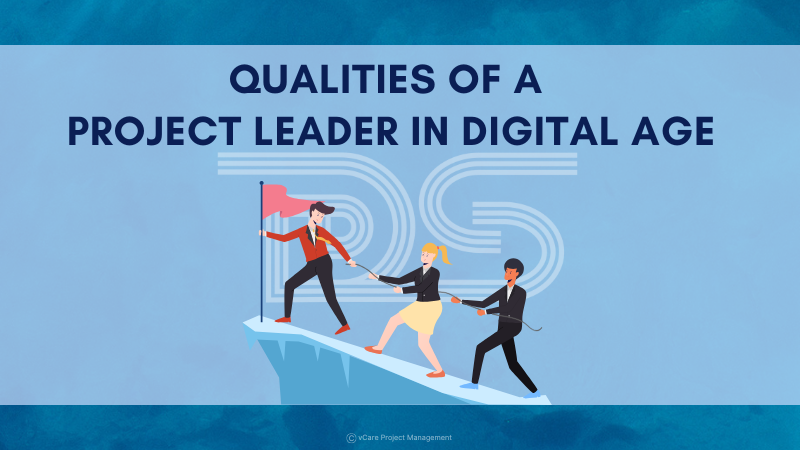









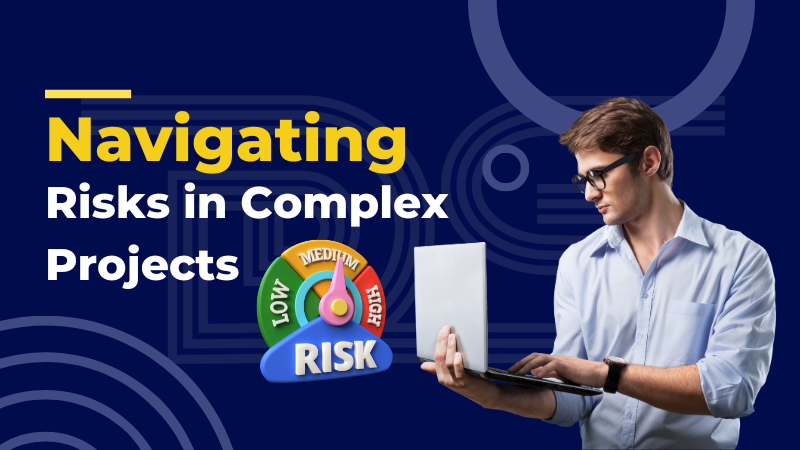
In the realm of project management, especially for complex projects, understanding and mitigating risks is crucial for success. Here are some key areas to focus on:
+ Stakeholder Response Integration: Anticipate stakeholder reactions to risks and proactively prepare strategies to address their concerns.
+ Monitoring Project Pace: Monitor project progress closely and be ready to intervene to maintain the timeline.
+ Leveraging Individual Competencies: Utilize the unique strengths of each team member to boost overall project performance.
+ Managing Interpersonal Dynamics: Foster effective communication and conflict resolution to ensure smooth team interactions.
+ Clarifying Contractual Agreements: Clearly define expectations, responsibilities, and deliverables in contracts to avoid misunderstandings.
+ Aligning with Organizational Culture: Understand and adapt to the organizational culture to facilitate smoother project implementation.
+ Effective Change Management: Implement robust change management processes to handle changes affecting stakeholders efficiently.
For more insights and to enhance your risk management skills while managing complex projects, join our PMI-RMP® Online Mentoring Programs: https://bit.ly/4bqgTws
🚀 Elevate Your Project Management Career:
– Register for my upcoming PMI Certification Success Story Webinars: https://bit.ly/4aVhrd6 / https://bit.ly/3QeVhKF
– Book an obligation-free consultation session on Project management Career, training, and certifications: http://talktodharam.com
– Discover training offers and certification discounts: https://bit.ly/3jWVepD
– Stay updated with our Q&A series and certification success stories by subscribing to the vCare Project Management YouTube channel at https://bit.ly/2YF0wJl
– Follow my podcasts and interviews with Project Management Experts on YouTube at https://bit.ly/2NDY8wd
#ProjectManagement #RiskManagement #ChangeManagement #ProjectRiskManagement #PMIRMP #StakeholderManagement #ComplexProjects #ProjectIntegration #TeamCompetencies #ContractManagement #OrganizationalCulture #ProjectStakeholders